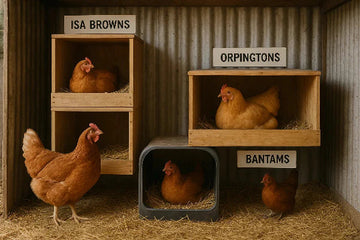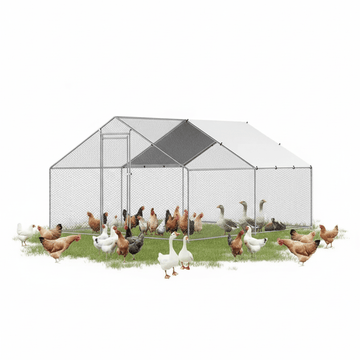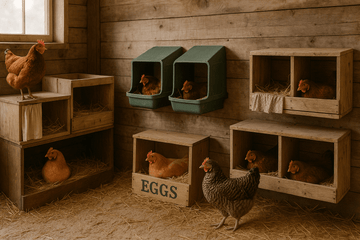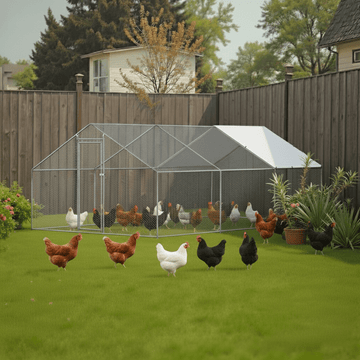It seems like such a simple question, right? But ask five chicken keepers what size a nesting box should be and you’ll probably get five different answers. The truth is, getting the dimensions right makes all the difference in how happy your hens are—and how many clean, unbroken eggs you collect.
Whether you’re setting up your first coop or rethinking your current setup, the right size isn’t just about fitting your chickens inside a box. It’s about creating a comfortable, private, hygienic, and accessible environment that your hens will happily return to each day to lay.
In this article, we’ll break down everything you need to know about chicken nesting box dimensions—from standard sizes for backyard flocks to custom adjustments based on breed and coop space. If you've ever wondered “how big should a chicken nesting box be?”—you’re in the right place.
Introduction
So, what’s the big deal about the size of a nesting box? Quite a lot, actually.
Your chickens are more likely to lay eggs consistently and safely in a box that feels cozy, safe, and just the right size. A box that’s too small will make them uncomfortable. Too big? They’ll invite roommates—and hens sharing boxes often means broken eggs, poop in the bedding, and unwanted drama.
This is especially true in Australia, where the diversity of chicken breeds—from Isa Browns and Australorps to big girls like Orpingtons—means a one-size-fits-all approach often falls short. Add in regional differences in climate and coop style, and getting dimensions right becomes even more important.
Over the next few sections, we’ll cover:
- Standard chicken nesting box dimensions
- Adjustments for different flock sizes and breeds
- The impact of placement and height
- Real-world examples from DIY to rollaway boxes
Let’s start with the basics.
Ideal Chicken Nesting Box Dimensions
There is a “Goldilocks zone” when it comes to nesting box dimensions—not too big, not too small, just right. Getting these measurements correct is the foundation of good coop design.
Standard Dimensions for Most Breeds
For the average hen (think: Isa Browns, Australorps, Leghorns), your box should be approximately:
- Width: 30 cm (12 inches)
- Height: 30–35 cm (12–14 inches)
- Depth: 30–35 cm (12–14 inches)
This gives hens enough space to enter, turn around, and nest comfortably. These dimensions are snug enough to discourage multiple hens from piling in but big enough for a single hen to stretch out and lay in peace.
Adjustments for Large or Small Breeds
For large breeds like Orpingtons, Brahmas, or Sussex, go a bit bigger:
- Width/Height/Depth: 35–40 cm (14–16 inches)
For bantams or smaller backyard layers:
- Width/Height/Depth: 25–28 cm (10–11 inches)
Don't go too small—even bantams like a bit of room to settle. And if you have a mixed flock, it's best to size for the largest breed and let the smaller hens adapt.
Entry Height and Perch Space
Don’t forget the entry design! Your hens should be able to step into the box without strain. Position the entry:
- Around 30–50 cm above the floor of the coop
- With a perch or landing bar right outside the opening
- Include a 5–7 cm lip at the front to hold in bedding and eggs
That lip helps keep things tidy without blocking access. Perches also support older or heavier hens, giving them an easy boost up.
Nesting Box Size Based on Flock Type
Different flock sizes = different nesting needs. Even with the right box size, you’ll need to match the number of boxes to the number of hens for best results.
For Backyard Layers (3–6 Hens)
You can get away with:
- 2 nesting boxes of standard size (30x30x30 cm)
- Placed side-by-side or in a corner of your coop
Chickens often share, but overcrowding leads to cracked eggs and stressed-out birds. More boxes means more comfort.
For Medium Flocks (7–15 Hens)
- Provide 4–5 boxes, depending on temperament and pecking order
- Consider a stacked vertical setup to save floor space
- Each box should still be 30–35 cm all around
Using a rollaway box like the Pets Gear 3-Hole Rollaway Nest Box is smart here. It supports multiple hens, keeps eggs clean, and saves serious collection time.
For Large or Commercial Flocks
Larger flocks need:
- 1 box for every 3–4 hens
- Multiple tiers or rows of boxes
- Stronger, durable materials like metal or hard plastic
Consider boxes with internal dividers or rollaway trays to prevent egg eating and overcrowding.
DIY Nesting Box Sizing Guide
If you're building your own boxes, here’s how to size them depending on the material you’re using.
Crate, Bucket, and Wooden Box Dimensions
- Milk Crates: Usually 30x30 cm—perfect size for most hens
- Plastic Tubs: Trim down tall sides, aim for a 12–14" opening
- 5-Gallon Buckets: Great for single hens; just lay them on their side and secure
Whatever you use, make sure the box is stable, won’t tip over, and has adequate bedding space.
Nest-to-Hen Ratio
Stick to this rule:
One box for every 3–4 hens
Even if hens take turns, crowding causes stress, broken eggs, and unwanted laying spots around the coop.
How to Modify for Limited Coop Space
Short on space? Try:
- Stacked boxes (up to 2 tiers high)
- Corner triangle boxes to fit unused spots
- External access boxes mounted on the outside of the coop
Just ensure airflow and light are managed properly—hens don’t like it drafty or bright.
Why Too Big or Too Small Is a Problem
When it comes to nesting boxes, size really does matter. Chickens are creatures of comfort and routine, and if their laying space isn’t just right, they’ll either avoid it completely—or worse, develop bad habits like egg-eating or laying in odd places.
Risks of Oversized Boxes
You might think giving your hens extra room is a good thing, but nesting boxes that are too large can cause more harm than good.
Here’s why:
- Multiple hens may pile in, leading to egg breakage
- It encourages sleeping in the nest, which means more droppings and dirt
- The hen doesn’t feel “tucked in,” which reduces her instinct to lay
Large boxes also make it harder to collect eggs in one clean place. Your hens might push eggs to the corners or bury them under bedding.
What Happens When Boxes Are Too Tight
Too-small boxes are equally problematic. If a hen can’t comfortably enter, turn, and settle, she’ll find another place to lay—or worse, become egg-bound from stress.
Small boxes:
- Can cause feather loss or pecking injuries due to friction
- Make hens anxious and unsettled
- Lead to laying in random coop corners or under bushes outside
It’s important to measure not just the box size, but also the entry space and lip height—older hens or large breeds struggle with narrow openings or high ledges.
Hygiene and Comfort Balance
Ultimately, nesting boxes need to be just big enough to be comfortable, but not so big that they become communal sleeping spots or mess magnets.
Here’s a simple checklist:
- ✅ The hen can enter and turn around
- ✅ She’s partially enclosed (dark and private)
- ✅ Bedding stays contained
- ✅ Only one hen fits comfortably at a time
- ✅ Eggs don’t roll too far from the center
That balance of size, cleanliness, and usability leads to more consistent egg production and happier hens overall.
Comparing Different Nesting Box Types by Size
Let’s take a look at how common nesting box types stack up in terms of size, capacity, and suitability. Here’s a quick reference:
🪵 Traditional Wooden Box
- Standard size: 30x30x30 cm
- Best for: Small backyard flocks
- Easy to DIY or customize
- Requires regular maintenance to prevent mites
🔄 Rollaway Nesting Box
- Size: Varies—usually 3-compartment, ~35 cm wide each
- Best for: Medium to large flocks
- Keeps eggs clean and unbroken
- Example: Pets Gear Rollaway Nest Box
🧺 Plastic Stackable Unit
- Compact: ~30x28x28 cm per unit
- Best for: Small flocks with modular setups
- Easy to clean, pest-resistant
- Can be wall-mounted to save space
Optimal Nesting Box Height and Placement
Now that we’ve nailed down box dimensions, it’s time to talk about where to put those boxes and how high off the ground they should be.
From Floor to Nest Box: How High Should They Be?
Standard nesting boxes should be:
- 30–60 cm above the coop floor
- Not higher than the lowest roosting bar (to prevent sleeping in them)
This keeps bedding clean, deters rodents, and gives hens a clear choice: nest low, sleep high.
Add a landing perch in front of the box if your hens need help getting in—especially helpful for larger or older birds.
Light, Privacy, and Airflow
Placement tips for happy hens:
- Nesting boxes should be in a dim, low-traffic area
- Avoid putting them under direct windows or vents
- If outdoors or external to the coop, insulate the boxes or shade them with a roof extension
Privacy is everything—hens love their “me time” when laying. If the boxes are too exposed or bright, you’ll end up with random eggs outside the coop.
Wall-Mount vs Floor-Mount Designs
Wall-mounted boxes are great for:
- Saving coop floor space
- Preventing bedding from being scratched out
- Easier access for cleaning and egg collection
Floor-mounted boxes work well for:
- Larger coops with more room
- Heavy breeds that don’t jump well
- DIY builds using crates, buckets, or tubs
Just remember: ventilation and cleaning access matter more than aesthetics. Go with what makes daily care easier for you.
Nesting Box Size Table by Breed (Visual Reference)
To make it even easier for you to determine the right nesting box size, here’s a quick-reference table based on the most common chicken breeds in Australia. This is especially handy for mixed flocks or when planning a new coop layout.
| 🐔 Chicken Breed | 📏 Suggested Box Size (W x H x D) | 📝 Notes |
|---|---|---|
| Isa Brown / Leghorn | 30 x 30 x 30 cm | Standard size, suitable for most hybrid egg-layers |
| Australorp | 30 x 35 x 35 cm | Taller birds need slightly more vertical room |
| Orpington / Sussex | 35 x 35 x 35 cm | Heavier breeds—make sure the entrance is wide enough |
| Bantam Breeds | 25 x 25 x 25 cm | Smaller boxes okay, but still provide a 5 cm front lip |
| Plymouth Rock / Rhode Island Red | 32 x 30 x 32 cm | Standard to mid-large; use extra bedding for comfort |
| Mixed Flock | 35 x 35 x 35 cm | Build for the largest birds to ensure all can use safely |
Tip: When in doubt, size up, but keep the entry cozy. Bigger is better only when it's not communal. Privacy still trumps square footage!
Tips for Space-Saving Nesting Box Designs
Not every backyard coop has tons of space to spare. Luckily, there are a few clever ways to maximize space without compromising comfort or egg yield.
Corner Nests, Vertical Stacks, and Multi-Level Designs
- Corner Nests: Triangle-shaped boxes that tuck into unused corners—great for small urban coops.
- Vertical Stack Boxes: Place 2 or 3 boxes directly above each other with space in between. Ideal for coops with high ceilings or walls.
- Multi-Level Stations: Use dividers and stacking methods to fit up to 6 boxes in a single wall section.
Just be sure to add perches and ramps if your hens struggle with height.
When and How to Build Outside-Mounted Boxes
Want to save interior space and make egg collection easier? External nesting boxes are a smart choice.
- Mounted on the outside wall of your coop
- Accessed via a hinged lid or back panel
- Keeps eggs away from the flock area (cleaner, cooler)
This design is ideal if you’re buying or replicating rollaway boxes like the Pets Gear Rollaway Nest Box. The external egg tray is a favorite feature for busy backyard keepers.
Common Mistakes in Nesting Box Dimensions
Getting the size wrong is surprisingly common—but totally avoidable. Here are the top issues we see and how to fix them:
Making Boxes Too Deep or Too High
Boxes that are too deep:
- Make it hard for hens to get in and out
- Result in eggs rolling into corners or bedding
Boxes that are too high off the ground:
- Discourage less agile hens
- Lead to laying elsewhere in the coop or outside
Fix: Stick to a box depth of 30–35 cm, and a height of 30–50 cm from the coop floor. Add a perch to help hens jump in and out easily.
Forgetting Hen Comfort or Access
Access is critical. If hens can’t reach the nest, they won’t use it. This includes:
- No landing bar or step
- Front lip too high (more than 7 cm)
- Entry hole too narrow for large breeds
Fix: Build with your flock in mind. Observe your hens’ size and mobility, and adjust entrances accordingly.
Not Accounting for Cleaning Ease
DIY boxes often forget one thing: how easy it is to clean. Cramped, poorly ventilated boxes become dirty fast—and no hen wants to lay in a stinky, mite-infested corner.
Fix: Build boxes with:
- Removable bottoms or trays
- Hinged lids or drop fronts
- Smooth interiors with minimal crevices
Want inspiration? Check out the design of the Pets Gear rollaway box—it nails all the practical details for cleaning, airflow, and egg safety.
FAQs About Chicken Nesting Box Dimensions
1. What’s the minimum space for one hen?
Ideally, each hen should have access to 30 x 30 x 30 cm of space for nesting. Even if hens share, they need the option to spread out to avoid stress.
2. Can two hens share one box?
Yes—but not at the same time. Most hens will wait their turn if there are enough boxes available. Overcrowding one box can lead to broken eggs and messy nests.
3. What if my hens aren’t using the boxes?
Check the following:
- Is the box too exposed or bright?
- Is it the wrong height?
- Is the bedding dirty or missing?
- Are the boxes the wrong size?
Fixing one of these usually solves the issue. You can also place a fake egg or golf ball inside to “hint” to the hens.
4. Can I make boxes stackable?
Absolutely. Just ensure there’s at least 25 cm between the top of one box and the bottom of the next. Add ramps or steps to help hens reach upper tiers.
5. Should nesting boxes be dark inside?
Yes! Hens prefer a quiet, dark place to lay. Use a lid, curtain, or partial cover to dim the light inside each box.
Conclusion
Finding the perfect size for your chicken nesting boxes is more than just picking numbers—it’s about understanding your flock, your coop space, and the daily habits of your hens. With the right dimensions, you’ll create a welcoming, safe, and efficient laying space that keeps both you and your chickens happy.
Remember the golden rules:
- 30 x 30 x 30 cm for standard hens
- Adjust for large or small breeds
- Keep boxes elevated but accessible
- Prioritize cleanliness, privacy, and one-hen occupancy
And if you ever feel stuck or want a pre-made solution that checks all the boxes (literally), check out the Pets Gear Nesting Box Collection—especially their best-selling 3-hole rollaway nest box.
FAQs (Quick Recap)
1. Can nesting boxes be square or rectangular?
Yes—square works well, but a slightly rectangular shape (more depth) can offer extra comfort for larger hens.
2. How many boxes for 10 hens?
Three to four boxes are ideal. Don’t overcrowd—hens value privacy.
3. What’s the best bedding to use in boxes?
Straw, pine shavings, or washable nest pads all work well. Avoid hay in humid climates.
4. Should I insulate nesting boxes?
Only in cold regions. Most Aussie coops don’t need insulation, but wind protection and dry bedding are key.
5. How do I stop hens from pooping in the boxes?
Make sure your roosts are higher than the nesting boxes. Hens want to sleep high—so give them a better option.





